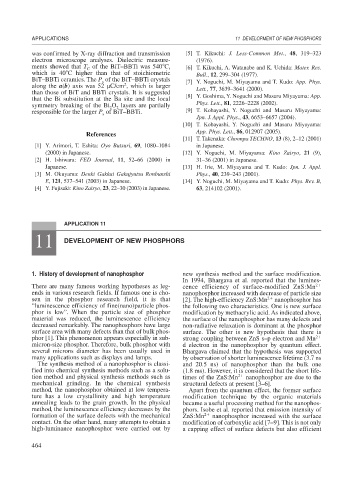Page 492 - Book Hosokawa Nanoparticle Technology Handbook
P. 492
APPLICATIONS 11 DEVELOPMENT OF NEW PHOSPHORS
was confirmed by X-ray diffraction and transmission [5] T. Kikuchi: J. Less-Common Met., 48, 319–323
electron microscope analyses. Dielectric measure- (1976).
ments showed that T of the BiT–BBTi was 540 C, [6] T. Kikuchi, A. Watanabe and K. Uchida: Mater. Res.
C
which is 40 C higher than that of stoichiometric Bull., 12, 299–304 (1977).
BiT–BBTi ceramics. The P of the BiT–BBTi crystals [7] Y. Noguchi, M. Miyayama and T. Kudo: App. Phys.
s
2
along the a(b) axis was 52 C/cm , which is larger Lett., 77, 3639–3641 (2000).
than those of BiT and BBTi crystals. It is suggested [8] Y. Goshima, Y. Noguchi and Masaru Miyayama: App.
that the Bi substitution at the Ba site and the local
symmetry breaking of the Bi O layers are partially Phys. Lett., 81, 2226–2228 (2002).
2
2
responsible for the larger P of BiT–BBTi. [9] T. Kobayashi, Y. Noguchi and Masaru Miyayama:
s
Jpn. J. Appl. Phys., 43, 6653–6657 (2004).
[10] T. Kobayashi, Y. Noguchi and Masaru Miyayama:
App. Phys. Lett., 86, 012907 (2005).
References
[11] T. Takenaka: Choonpa TECHNO, 13 (8), 2–12 (2001)
[1] Y. Arimori, T. Eshita: Oyo Butsuri, 69, 1080–1084 in Japanese.
(2000) in Japanese. [12] Y. Noguchi, M. Miyayama: Kino Zairyo, 21 (9),
[2] H. Ishiwara: FED Journal, 11, 52–66 (2000) in 31–36 (2001) in Japanese.
Japanese. [13] H. Irie, M. Miyayama and T. Kudo: Jpn. J. Appl.
[3] M. Okuyama: Denki Gakkai Gakujyutsu Ronbunshi Phys., 40, 239–243 (2001).
E, 121, 537–541 (2003) in Japanese. [14] Y. Noguchi, M. Miyayama and T. Kudo: Phys. Rev. B,
[4] Y. Fujisaki: Kino Zairyo, 23, 22–30 (2003) in Japanese. 63, 214102 (2001).
APPLICATION 11
11 DEVELOPMENT OF NEW PHOSPHORS
1. History of development of nanophosphor new synthesis method and the surface modification.
In 1994, Bhargava et al. reported that the lumines-
There are many famous working hypotheses as leg- cence efficiency of surface-modified ZnS:Mn 2
ends in various research fields. If famous one is cho- nanophosphor increased with decrease of particle size
sen in the phosphor research field, it is that [2]. The high-efficiency ZnS:Mn 2 nanophosphor has
“luminescence efficiency of fine(nano)particle phos- the following two characteristics. One is new surface
phor is low”. When the particle size of phosphor modification by methacrylic acid. As indicated above,
material was reduced, the luminescence efficiency the surface of the nanophosphor has many defects and
decreased remarkably. The nanophosphors have large non-radiative relaxation is dominant at the phosphor
surface area with many defects than that of bulk phos- surface. The other is new hypothesis that there is
phor [1]. This phenomenon appears especially in sub- strong coupling between ZnS s–p electron and Mn 2
micron-size phosphor. Therefore, bulk phosphor with d electron in the nanophosphor by quantum effect.
several microns diameter has been usually used in Bhargava claimed that the hypothesis was supported
many applications such as displays and lamps. by observation of shorter luminescence lifetime (3.7 ns
The synthesis method of a nanophosphor is classi- and 20.5 ns) of nanophosphor than the bulk one
fied into chemical synthesis methods such as a solu- (1.8 ms). However, it is considered that the short life-
tion method and physical synthesis methods such as times of the ZnS:Mn 2 nanophosphor are due to the
mechanical grinding. In the chemical synthesis structural defects at present [3–6].
method, the nanophosphor obtained at low tempera- Apart from the quantum effect, the former surface
ture has a low crystallinity and high temperature modification technique by the organic materials
annealing leads to the grain growth. In the physical became a useful processing method for the nanophos-
method, the luminescence efficiency decreases by the phors. Isobe et al. reported that emission intensity of
formation of the surface defects with the mechanical ZnS:Mn 2 nanophosphor increased with the surface
contact. On the other hand, many attempts to obtain a modification of carboxylic acid [7–9]. This is not only
high-luminance nanophosphor were carried out by a capping effect of surface defects but also efficient
464

